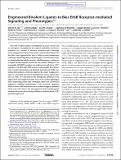Engineered Bivalent Ligands to Bias ErbB Receptor-mediated Signaling and Phenotypes
Author(s)
Jay, Steven M.; Kurtagic, Elma; Alvarez, Luis M.; De Picciotto, Seymour; Hawkins, Jessica F.; Prince, Robin N.; Guerrero, Yadir; Treasure, Carolyn L.; Lee, Richard T.; Griffith, Linda G.; Sanchez, Edgar; ... Show more Show less
DownloadGriffith_Engineered bivalent.pdf (2.046Mb)
PUBLISHER_CC
Publisher with Creative Commons License
Creative Commons Attribution
Terms of use
Metadata
Show full item recordAbstract
The ErbB receptor family is dysregulated in many cancers, and its therapeutic manipulation by targeted antibodies and kinase inhibitors has resulted in effective chemotherapies. However, many malignancies remain refractory to current interventions. We describe a new approach that directs ErbB receptor interactions, resulting in biased signaling and phenotypes. Due to known receptor-ligand affinities and the necessity of ErbB receptors to dimerize to signal, bivalent ligands, formed by the synthetic linkage of two neuregulin-1β (NRG) moieties, two epidermal growth factor (EGF) moieties, or an EGF and a NRG moiety, can potentially drive homotypic receptor interactions and diminish formation of HER2-containing heterodimers, which are implicated in many malignancies and are a prevalent outcome of stimulation by native, monovalent EGF, or NRG. We demonstrate the therapeutic potential of this approach by showing that bivalent NRG (NN) can bias signaling in HER3-expressing cancer cells, resulting in some cases in decreased migration, inhibited proliferation, and increased apoptosis, whereas native NRG stimulation increased the malignant potential of the same cells. Hence, this new approach may have therapeutic relevance in ovarian, breast, lung, and other cancers in which HER3 has been implicated.
Date issued
2011-05Department
Massachusetts Institute of Technology. Center for Gynepathology Research; Massachusetts Institute of Technology. Department of Biological Engineering; Koch Institute for Integrative Cancer Research at MITJournal
Journal of Biological Chemistry
Publisher
American Society for Biochemistry and Molecular Biology (ASBMB)
Citation
Jay, S. M. et al. “Engineered Bivalent Ligands to Bias ErbB Receptor-mediated Signaling and Phenotypes.” Journal of Biological Chemistry 286.31 (2011): 27729–27740. © 2011 by The American Society for Biochemistry and Molecular Biology, Inc.
Version: Final published version
ISSN
0021-9258
1083-351X